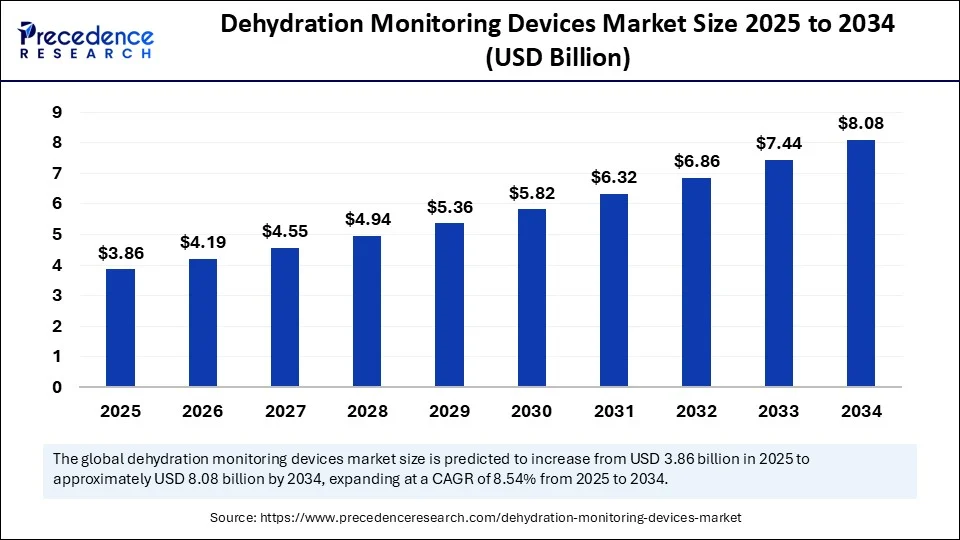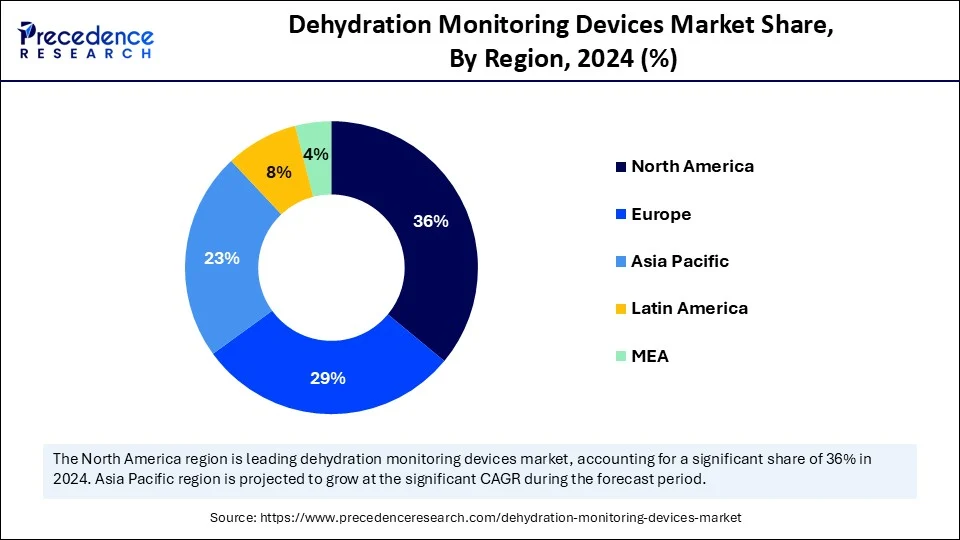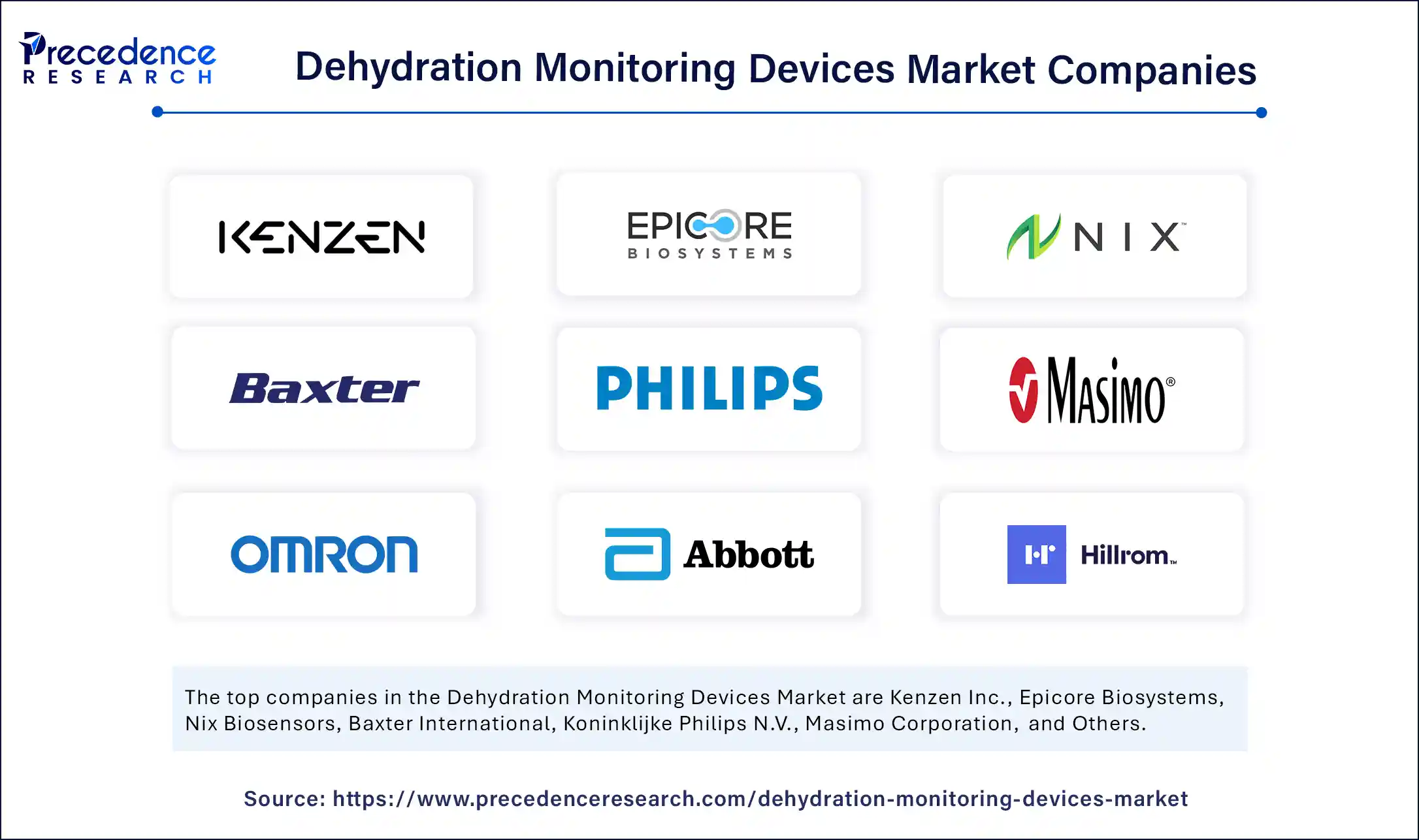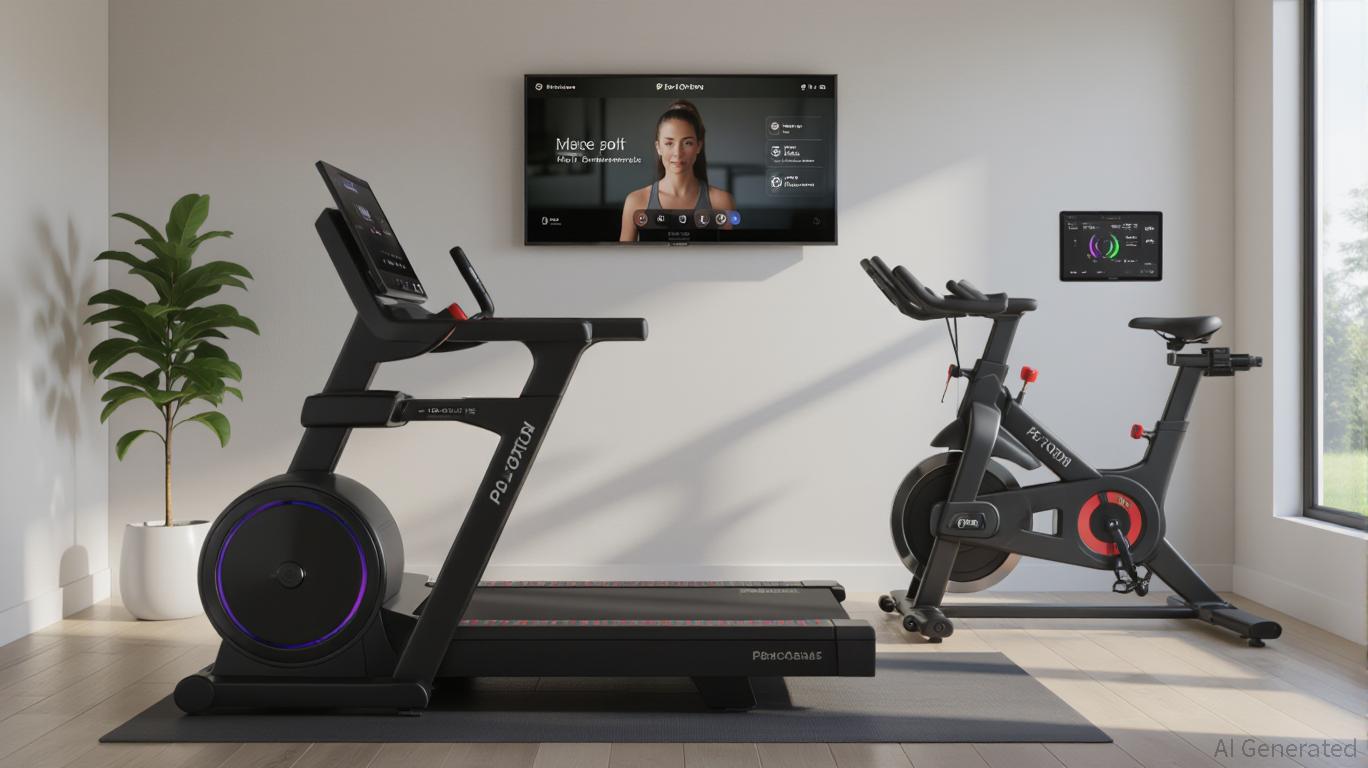Dehydration Monitoring Devices Market Size and Forecast 2025 to 2034
The global dehydration monitoring devices market size accounted for USD 3.56 billion in 2024 and is predicted to increase from USD 3.86 billion in 2025 to approximately USD 8.08 billion by 2034, expanding at a CAGR of 8.54% from 2025 to 2034. The market is experiencing substantial growth due to increasing awareness of health risks related to fluid imbalances, as well as rising cases of dehydration among the elderly and pediatric populations. This growth is further supported by advancements in wearable and non-invasive monitoring technologies.
Dehydration Monitoring Devices Market Key Takeaways
- In terms of revenue, the global dehydration monitoring devices market was valued at USD 3.56 billion in 2024.
- It is projected to reach USD 8.08 billion by 2034.
- The market is expected to grow at a CAGR of 8.54% from 2025 to 2034.
- North America dominated the dehydration monitoring devices market with the largest share of 36% in 2024.
- Asia Pacific is expected to grow at the fastest CAGR from 2025 to 2034.
- By product type, the non-wearable dehydration monitors segment led the market in 2024.
- By product type, the wearable dehydration monitors segment is expected to experience the fastest growth during the projection period.
- By application, the clinical segment captured the biggest market share of 38% in 2024.
- By application, the sports & fitness segment is expected to grow at a significant CAGR over the projected period.
- By end user, the hospitals & clinics segment contributed the highest market share of 41% in 2024.
- By end user, the military & defense facilities segment is anticipated to grow at a significant CAGR from 2025 to 2034.
- By technology, the bioelectrical impedance analysis (BIA) segment held the biggest market share of 29% in 2024.
- By technology, the biosensors segment is likely to expand at a significant CAGR from 2025 to 2034.
- By distribution channel, the direct tenders / B2B sales segment generated the major market share of 46% in 2024.
- By distribution channel, the online sales channels segment is projected to grow at a significant CAGR between 2025 and 2034.
How Can AI Impact the Dehydration Monitoring Devices Market?
Artificial intelligence (AI) is revolutionizing this market by enhancing device accuracy, personalization, and efficiency. AI algorithms analyze complex biometric data from wearables to offer real-time hydration assessments and customized recommendations. They can alert users during physical activity or for vulnerable groups, preventing dehydration. AI also integrates hydration data with other health metrics, such as activity, sleep, and diet, providing a comprehensive view of health and wellness. Moreover, AI can predict potential dehydration risks by analyzing real-time and historic data, enabling proactive interventions.
U.S. Dehydration Monitoring Devices Market Size and Growth 2025 to 2034
The U.S. dehydration monitoring devices market size was evaluated at USD 897.12 billion in 2024 and is projected to be worth around USD 2,079.19 billion by 2034, growing at a CAGR of 8.77% from 2025 to 2034.
What Made North America the Dominant Region in the Dehydration Monitoring Devices Market in 2024?
North America dominated the dehydration monitoring devices market by capturing the largest share in 2024, primarily due to its advanced healthcare infrastructure, high healthcare expenditure, and high adoption of wearable technology. The region benefits from robust distribution networks, supportive government initiatives, and a growing awareness of preventive healthcare and fitness. The region’s substantial investment in healthcare allows for greater investment in research and development of advanced medical technologies, including dehydration monitoring devices. While no specific recent government initiative directly focuses solely on dehydration monitoring devices, the overall support for digital health and remote patient monitoring contributes significantly to the market’s growth.
U.S. Dehydration Monitoring Devices Market Trends
The U.S. is a major contributor to the market due to its advanced healthcare infrastructure, high awareness of the impact of hydration on health & performance, and rising participation in sports and fitness. The country leads in the adoption and development of sophisticated devices, such as wearable sensors. Its emphasis on digital health and remote patient monitoring, supported by government initiatives, creates robust demand for these technologies. This commitment to innovation and widespread adoption solidifies the U.S.’s leading position in the market. Moreover, an aging population further contributes to market growth.
What Makes Asia Pacific the Fastest-Growing Region in the Dehydration Monitoring Devices Market?
Asia Pacific is expected to experience the fastest growth in the market due to various factors, including rising healthcare awareness, expanding middle-class populations, and hot climate conditions, particularly in countries like India and Southeast Asia. Increased awareness of the importance of hydration and its impact on overall health is driving demand for dehydration monitoring devices. Growing disposable incomes in the region allow for greater spending on health and wellness products, including hydration monitoring devices. This growth is further fueled by increasing sports activities, fitness trends, and the digital health revolution, leading to a demand for hydration monitoring solutions. The rising adoption of wearable technology and digital health solutions is also contributing to the hydration monitoring market’s growth, as these devices often come with hydration tracking features.
China Dehydration Monitoring Devices Market Trends
China represents a rapidly expanding market, primarily driven by its large geriatric population, coupled with changing lifestyles and a rising awareness of health and fitness, creating significant demand for such devices. The Chinese government’s focus on strengthening community healthcare infrastructure and promoting technology-driven wellness services further supports market growth. Additionally, China’s tech-savvy population is quick to adopt wearable health technologies, including hydration trackers, and the country’s strong local production capabilities and innovation hubs facilitate access to the market across diverse income levels.
Why is Europe Considered a Notable Region in the Dehydration Monitoring Devices Market?
Europe is expected to experience notable growth in the foreseeable future. This is primarily due to a growing awareness of fitness and health, technological advancements in monitoring systems, and the increasing prevalence of chronic diseases that often require careful hydration management. Industries such as mining, construction, and manufacturing are adopting these systems to ensure worker safety and prevent dehydration-related incidents in high-temperature or physically demanding environments. Innovations in sensor technology, miniaturization of devices, and integration with health tracking apps are making dehydration monitoring more convenient and accessible. Collaborations, such as the EU-India research initiatives on water challenges, are also contributing to advancements in monitoring technologies and their application across various sectors.
What Opportunities Exist in Latin America for the Dehydration Monitoring Devices Market?
Latin America presents substantial opportunities for the market, with an increasing prevalence of chronic diseases and advancements in wearable technology. There is a rising prevalence of dehydration-related illnesses, particularly among the elderly, and the expanding adoption of portable and non-invasive monitoring devices. While specific government initiatives directly targeting dehydration monitoring devices are not widely documented, Latin American countries are actively investing in healthcare devices, e-health initiatives, and collaborations that indirectly support the growth of this market, facilitating the adoption of dehydration monitoring devices. Moreover, increasing awareness of hydration’s importance supports regional market growth.
What Factors Contribute to the Dehydration Monitoring Devices Market in the Middle East & Africa?
The market in the Middle East & Africa is expected to grow at a steady rate in the upcoming period, driven by the rising prevalence of chronic diseases, increasing healthcare awareness, and the region’s arid climate, leading to dehydration. The growing elderly population, who are more susceptible to dehydration, further elevates the demand for effective hydration monitoring solutions. The regional market growth is fueled by the increasing demand for wearable and remote monitoring solutions and a focus on proactive healthcare management. There is a rising awareness among individuals in the region regarding the importance of proper hydration, leading to the high adoption of these devices for hydration management.
Market Overview
The dehydration monitoring devices market includes technologies and equipment designed to continuously or intermittently assess hydration status in individuals. These devices detect physiological markers such as body water levels, urine concentration, bioelectrical impedance, or blood parameters to identify fluid imbalances that can lead to dehydration. Applications range from clinical care, especially for elderly and pediatric populations, to sports medicine, military and occupational health, and home care settings. These devices are vital for early dehydration detection, helping to reduce complications like electrolyte imbalance, cognitive decline, renal stress, and hospitalization. The growth of the market is driven by the increased use of smart medical sensors, rising interest from the sports industry, and the development of non-invasive monitoring solutions.
What are the Key Trends in the Dehydration Monitoring Devices Market?
- Growing Use in the Sports & Fitness Industry: The increasing participation in sports and fitness activities, along with the need to optimize performance and prevent dehydration-related issues, is creating new opportunities for hydration monitoring devices.
- Demand for Remote Patient Monitoring: The rise of remote patient monitoring in healthcare is also contributing to market growth, as these devices can be used to track patients’ hydration levels remotely, particularly in chronic care management.
- Technological Advancements: Ongoing developments in sensor technology, especially in biological and chemical sensors, are driving the creation of more accurate, convenient, and affordable dehydration monitoring devices.
- Shifting Healthcare Landscape: There is also a growing emphasis on preventative care and personalized healthcare, which is increasing the demand for non-invasive and convenient monitoring solutions like wearable hydration sensors.
- Product Innovation: Ongoing product launches of innovative solutions, including automatic hydration testing systems and sweat sensors, are further accelerating market growth.
Market Scope
| Report Coverage |
Details |
| Market Size by 2034 |
USD 8.08 Billion |
| Market Size in 2025 |
USD 3.86 Billion |
| Market Size in 2024 |
USD 3.56 Billion |
| Market Growth Rate from 2025 to 2034 |
CAGR of 8.54% |
| Dominating Region |
North America |
| Fastest Growing Region |
Asia Pacific |
| Base Year |
2024 |
| Forecast Period |
2025 to 2034 |
| Segments Covered |
Product Type, Application, End User, Technology, Distribution Channel, and Region |
| Regions Covered |
North America, Europe, Asia-Pacific, Latin America, and Middle East & Africa |
Market Dynamics
Drivers
Growing Awareness of the Importance of Hydration
The primary factor driving the growth of the dehydration monitoring devices market is the growing awareness of the importance of hydration for health and disease prevention. Technological advances have also led to more accurate and user-friendly devices. Populations like the elderly and athletes are more prone to dehydration, boosting demand for monitoring solutions. Both individuals and healthcare providers are seeking preventative measures and continuous monitoring to avoid dehydration-related problems. These devices are increasingly integrated into fitness trackers and smartwatches, making hydration assessment a part of daily health management.
Restraint
High Cost of Advanced Wearable Technologies
A key restraint in the dehydration monitoring devices market is the high cost of advanced wearable technologies, which limits their adoption in regions with limited financial resources, especially in low-income and underdeveloped areas. The lack of standardization in device accuracy and regulatory approvals can also create confusion among consumers and healthcare providers, potentially acting as a barrier to entry for both parties. This restricts access to these tools in areas where they could be most beneficial.
Opportunity
Integrating Advanced Technologies
Looking ahead, a major opportunity lies in integrating advanced technologies such as AI and wearable sensors for personalized, continuous hydration monitoring. Devices are evolving to provide real-time, tailored hydration insights based on individual needs and activity levels. This trend is fueled by the increasing demand for early dehydration detection, especially among athletes, the elderly, and patients with chronic illnesses. Moreover, dehydration monitoring devices are being incorporated into telehealth platforms for remote patient care, enabling timely intervention and preventive strategies.
Product Type Insights
What Made Non-Wearable Dehydration Monitors the Dominant Segment in the Dehydration Monitoring Devices Market in 2024?
The non-wearable dehydration monitors segment dominated the market in 2024, with urine analysis devices holding the largest share as a sub-segment. This is due to their proven accuracy, cost-effectiveness, and availability. These devices analyze urine samples to assess hydration and are favored in clinical settings for diagnosing dehydration-related conditions. Compared to some wearable options, urine analysis is often less expensive, especially in high-volume hospital and clinic environments. Though wearable devices are gaining popularity, urine analysis remains a reliable, practical choice for routine hydration monitoring.
The wearable dehydration monitors segment is expected to grow at the fastest rate over the forecast period, under which the sweat sensors sub-segment is leading. This is primarily due to the increasing adoption of wearable technology and a growing awareness of the benefits of personalized health monitoring. As these sweat sensors are increasingly being integrated into smart textiles, such as clothing and wristbands, they allow for discreet and continuous monitoring. These sensors offer a non-invasive, real-time way to track hydration levels, electrolyte balance, and overall health by analyzing sweat. Advances in sensor tech combined with AI and data analytics provide personalized insights and feedback.
Application Insights
How Does the Clinical Segment Dominate the Dehydration Monitoring Devices Market in 2024?
The clinical segment dominated the market in 2024, with hospital use was the leading sub-segment. This is mainly due to the increased need for accurate, reliable monitoring in clinical environments, especially given the rise in dehydration-related illnesses and an aging population. These devices are used for diagnosis, treatment monitoring, and managing dehydration, mainly among vulnerable patients. The elderly are more susceptible due to diminished thirst and kidney function, increasing the need for effective monitoring. Hospitals have the infrastructure to incorporate new dehydration monitoring technologies.
The sports & fitness segment is expected to expand at the fastest CAGR, with the athlete hydration management sub-segment is leading. The growing focus on performance optimization and injury prevention in sports and fitness activities fuels the growth of this segment. Athletes and fitness enthusiasts increasingly use hydration devices to track fluid levels during training and competition, aiming to boost performance, prevent fatigue, and speed recovery. Rising participation in sports and fitness activities worldwide propels the demand for dehydration monitoring devices.
End User Insights
Why Did the Hospitals & Clinics Segment Lead the Dehydration Monitoring Devices Market in 2024?
The hospitals & clinics segment led the market in 2024, driven by high rates of dehydration-related hospitalizations and the need for precise, real-time monitoring in critical care. This leadership is reinforced by the increasing prevalence of chronic diseases, the aging demographic, and the push for advanced disease management technologies. Intensive care units and long-term care facilities require continuous hydration monitoring to avoid complications. Hospitals are equipped to adopt a broad range of sophisticated devices, including multi-parameter monitors, ECG monitors, and respiratory systems that integrate with dehydration monitoring tools.
The military & defense facilities segment is likely to experience the fastest growth in the market, driven by stringent regulations, government incentives, and a focus on soldier health and performance. Military organizations are increasingly adopting standards and mandates for hydration monitoring to ensure optimal soldier performance and prevent dehydration-related issues that can significantly impact combat readiness. Recognizing the critical link between hydration and soldier performance, especially in extreme environments, the military is prioritizing the monitoring of hydration levels to help prevent heat stroke, fatigue, and other conditions that degrade performance, further increasing their acceptance and usage.
Technology Insights
What Made Bioelectrical Impedance Analysis (BIA) the Dominant Segment in the Dehydration Monitoring Devices Market in 2024?
The bioelectrical impedance analysis (BIA) segment dominated the market in 2024. This dominance is largely due to BIA’s non-invasive, quick, and relatively inexpensive nature, offering a convenient way to estimate body composition and hydration levels. BIA operates by sending a low-level electrical current through the body and measuring its resistance; since water conducts electricity well, the amount of impedance directly correlates with body water levels. This makes BIA a valuable tool for assessing hydration status, as dehydration results in increased impedance, making it accessible for various settings, including home use, and suitable for rapid assessments.
The biosensors segment is likely to grow at a significant rate during the forecast period. This growth is primarily attributed to their non-invasive and continuous monitoring capabilities, providing real-time insights into hydration status. Biosensors can detect various biomarkers in bodily fluids, offering a more comprehensive view of hydration levels compared to traditional methods. The fluids contain numerous biomarkers related to hydration, such as electrolytes, metabolites, and hormones, all of which biosensors can detect and quantify. Ongoing advancements in flexible electronics, microfluidics, and nanomaterials are enhancing the sensitivity, accuracy, and portability of biosensors.
Distribution Channel Insights
How Did the Direct Tenders / B2B Sales Segment Dominate the Dehydration Monitoring Devices Market in 2024?
The direct tenders / B2B sales segment led the market in 2024. This is due to the broad applications of dehydration monitoring devices in institutional settings like hospitals and clinics. Direct sales provide manufacturers with greater control over pricing, distribution, and customer relationships. By offering tailored solutions that meet specific institutional needs, manufacturers can ensure their devices adhere to the required specifications and performance standards. Achieving this level of control is often more challenging through indirect distribution channels. Furthermore, dehydration monitoring devices, particularly those used in clinical settings, typically involve bulk purchases by hospitals, clinics, and other healthcare providers.
The online sales channels segment is expected to expand at the highest CAGR in the upcoming period. The growth of the segment is primarily driven by increasing consumer preferences for convenience and broader product access through e-commerce platforms. The segment’s growth is further reinforced by the rise of e-commerce, direct-to-consumer sales, and a growing comfort level with online purchasing. Many companies are adopting direct-to-consumer models that facilitate better control over customer experience and potentially higher profit margins, creating a more comprehensive and effective distribution strategy. Online platforms offer competitive pricing, discounts, and doorstep delivery, attracting more consumers.
Dehydration Monitoring Devices Market Companies
- Kenzen Inc.
- Epicore Biosystems
- Nix Biosensors
- Baxter International
- Koninklijke Philips N.V.
- Masimo Corporation
- Omron Healthcare
- Abbott Laboratories
- Hillrom (Baxter)
- Bodimetrics
- BSX Technologies
- Hexoskin
- iHydrate
- Tiger Tech Solutions
- Empatica Inc.
- Seca GmbH & Co.
- BodiMetrics
- Withings
- Welch Allyn
- VivaLNK
Recent Developments
- In June 2025, Nix launched its hydration biosensor in Great Britain and Ireland, marking its first direct-to-consumer expansion outside of North America. The small arm patch employs AI-enabled sensors to measure fluid and electrolyte loss during exercise, offering users a personalized sweat profile to optimize their rehydration strategies based on their sweat composition. (Source: https://www.sportive.com)
- In April 2024, Epicore Biosystems launched Connected Hydration, a wearable patch and mobile app designed to provide customized insights on sweat loss, electrolyte levels, and body temperature. This technology aims to protect workers in physically intensive industries from dehydration and heat-related injuries, especially as rising temperatures due to climate change pose significant challenges to working conditions. (Source: https://www.prnewswire.com)
- In March 2025, Nix Biosensors announced a partnership with LEGACY MOTOR CLUB as the official hydration biosensor supplier, aimed at enhancing the performance of drivers and pit crews in the demanding sport of racing. The hydration biosensor provides critical data for managing fluid intake, which is essential for maintaining peak performance during races. (Source: https://www.endurancesportswire.com)
Segments Covered in the Report
By Product Type
- Wearable Dehydration Monitors
- Sweat Sensors
- Skin Conductance Monitors
- Optical Sensing Wearables (e.g., smartwatches with hydration alerts)
- Others
- Non-Wearable Dehydration Monitors
- Urine Analysis Devices
- Blood/Serum Osmolality Analyzers
- Bioelectrical Impedance Devices
- Body Composition Analyzers
- Others
By Application
- Clinical
- Hospital Use
- Outpatient/Clinic Settings
- Emergency Care
- Sports & Fitness
- Athlete Hydration Management
- Military / Tactical Hydration Use
- Homecare
- Occupational Health
- Research and Academia
- Others
By End User
- Hospitals & Clinics
- Ambulatory Surgical Centers
- Sports Organizations & Athletic Institutions
- Military & Defense Facilities
- Home Users / Personal Use
- Academic & Research Institutions
- Occupational Safety Departments
- Others
By Technology
- Bioelectrical Impedance Analysis (BIA)
- Spectroscopy (Near-Infrared, Raman)
- Biosensors (Sweat, Saliva, Urine)
- Urinalysis-based Detection
- Optical Sensors / Photoplethysmography
- Others
By Distribution Channel
- Direct Tenders / B2B Sales
- Retail Pharmacies & Medical Device Stores
- Online Sales Channels
- Others
By Region
- North America
- Europe
- Asia Pacific
- Latin America
- Middle East & Africa





































































